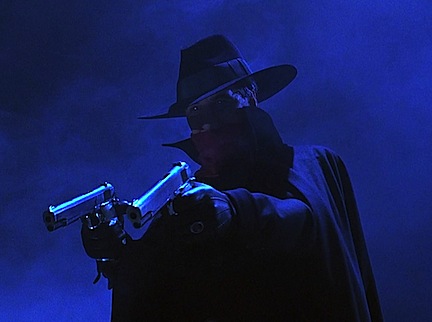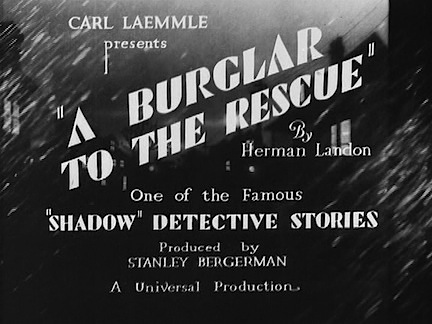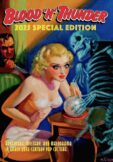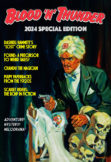EDitorial Comments
THE SHADOW (1994) on Blu-ray
In 1997 Universal entered the fledgling DVD market with four titles, one of them being The Shadow, starring Alec Baldwin as the cloaked crimefighter of pulp and radio fame. The Russell Mulcahy-directed film, released in 1994 to mixed reviews, had previously been made available to collectors in both VHS and laserdisc form. Curiously, the Shadow DVD did not preserve the theatrical version’s aspect ratio of 1.85:1, as did the laser version. Instead, the smaller disc presented a transfer that cropped the image to 4:3 — the dimensions of a typical TV screen in the days before 16×9 sets became common. Serious cineastes and Shadow fans were disappointed, although it’s safe to say that most consumers didn’t care one way or the other. The movie’s sales were respectable but underwhelming no matter what the format, and while the DVD’s inclusion of a transfer intended for pay-cable networks was most likely a mistake, Universal wasn’t about to incur additional expense to rectify the error. Not for a movie that the general public had received with such indifference.
When Blu-ray got its big consumer rollout in 2006, I hoped that The Shadow would be among Universal’s early releases in the new high-definition format. I knew for a fact that the studio’s video division had received complaints about the DVD, but I also knew that nobody there had much confidence in the film. Seven years later, we finally have a Blu-ray boasting a new high-definition (1080p) transfer of the original widescreen version. In the interest of brevity I’ll assume that most readers of this blog are familiar with The Shadow and need no recapitulation of the plot.
To begin with, I’m happy to report that image and sound quality are excellent, although one could quibble with the color correction of some shots. The opening sequence that takes place in China (filmed in one of my favorite locations, the Alabama Hills of Lone Pine, California) has a yellowish cast. Likewise, during the Cranston-Khan confrontation in the Chinese restaurant, both men seem to have saffron skin. And I noticed that in a few shots Penelope Ann Miller’s lipstick looks more orange than bright red. Such minor tinting anomalies usually demonstrate an overall bias toward the spectrum’s warmer colors, but the blues, browns and greens are rich and vivid. Maybe I’m being too fussy. Don’t get me wrong; this is a fine-looking transfer. But since Blu-ray has a reputation for pictorial superiority, we’re entitled to pick nits now and then.
Regarding the movie itself: I’ve always had a love-hate relationship with The Shadow. At its most effective — for example, in the first-act sequence in which The Shadow rescues Dr. Roy Tam — the film will evoke fannish memories of the character at his best, both in the pulps and on the air. Yet Russell Mulcahy’s direction is uneven and the shifts in tone extremely disconcerting. No matter how many times I see this film, I’ll always cringe when Lamont Cranston and Shiwan Khan trade quips about their haberdashery. And am I the only one who thinks Baldwin and Miller exhibit no chemistry in their scenes together?
But the thing that’s always bothered me most about The Shadow is its ill-advised attempt to reconcile the differences between the character’s pulp and radio incarnations. For example, if the movie’s Shadow can cloud men’s minds, why does he need to wear the hat and cloak at all? And why, given that Lamont Cranston is established as a handsome man, does The Shadow “morph” into a hawk-nosed figure, recognizable only to those viewers familiar with the pulp magazine’s iconography? That visage is acceptable to readers of the original Shadow stories because Lamont Cranston and Kent Allard were described as having similar facial features. The morphing makes no sense to viewers who aren’t conversant with Shadow lore.
Still, Mulcahy’s Shadow has much to recommend it, and I have to admit I’m delighted to finally have a high-definition version in the proper aspect ratio. What I can’t forgive, however, is Universal’s refusal to add so much as a coming-attractions trailer by way of supplemental features. Especially since the studio had some pips at its disposal….
As readers of Blood ‘n’ Thunder have long known, The Shadow made his first screen appearance in a 1931 short subject, “A Burglar to the Rescue,” which was the initial entry in a six-installment series of “Shadow Detective” featurettes produced and released by…Universal Pictures. Unseen for more than 70 years, “Burglar” turned up at a Los Angeles film festival after being found and preserved by Universal. Subsequently the studio unearthed three additional Shadow featurettes; to the best of my knowledge, the whereabouts of the remaining two have not yet been ascertained. But the second short, “Trapped,” was also preserved from original 35mm film elements.
It would have cost Universal very little to include “Burglar to the Rescue” and “Trapped” on the new Shadow Blu-ray. Their presence might not have attracted many buyers, but it certainly wouldn’t have discouraged any. And adding the featurettes might very well have been a shrewd marketing move, especially had their historical importance been played up in the disc’s marketing and advertising.
For those who don’t know, the “Shadow Detective” shorts — “two-reelers” with running times of approximately 20 minutes each — utilized the same format of radio’s Detective Story Hour, which debuted in 1930 and had The Shadow as a narrator of mystery yarns adapted from Street & Smith’s Detective Story Magazine. The weekly broadcast was such a hit that the mysterious narrator was fleshed out by freelance writer Walter B. Gibson and given a pulp magazine of his own. The rest, as they say, is history. “Burglar to the Rescue” was produced in New York City, where the radio show originated. Frank Readick, who by this time had made the character a nationwide sensation, lent his sepulchral tones to the celluloid Shadow and in all likelihood also appeared in hat and cloak: The Shadow seen in the frame capture below looks very much like publicity photos taken of Readick in costume to promote Detective Story Hour.
The “Shadow Detective” shorts aren’t world-beaters by any means; their historical value far outweighs their entertainment value. But Universal missed a bet by not including at least a couple of them on the Blu-ray.
PulpFest Is Coming Up Fast!
 The fifth annual PulpFest begins exactly eight weeks from today, on July 26. It continues the four-decades-old tradition of staging a major summer convention for fans and collectors of American popular fiction, specifically that which appeared in woodpulp magazines published during the first half of the 20th century. While other such events — especially the Windy City Pulp and Paper Convention — have come to prominence in recent years, PulpFest continues to be Ground Zero for devotees of the escapist fiction that has mightily influenced our pop culture.
The fifth annual PulpFest begins exactly eight weeks from today, on July 26. It continues the four-decades-old tradition of staging a major summer convention for fans and collectors of American popular fiction, specifically that which appeared in woodpulp magazines published during the first half of the 20th century. While other such events — especially the Windy City Pulp and Paper Convention — have come to prominence in recent years, PulpFest continues to be Ground Zero for devotees of the escapist fiction that has mightily influenced our pop culture.
This year’s convention will once again be held at the Hyatt Regency Hotel in downtown Columbus, Ohio. After considerable searching for a new location, PulpFest moved to the Regency last year. With minor reservations, the committee (which includes your humble correspondent) found it far more comfortable and convenient than the previous venue, whose level of service deteriorated steadily during our years there. The Regency isn’t perfect, but the vast majority of last year’s attendees seemed quite satisfied. I can report that the committee has worked hard to address the few complaints it did receive, and I firmly believe 2013’s confab will improve on the 2012 experience.
It’ll certainly be a big show for Murania Press, as I intend to debut the new Blood ‘n’ Thunder Guide to Pulp Fiction there, along with the Summer 2013 issue of BnT and at least one new volume in our Classic Pulp Reprints series.
For the last few years Ohio State University has sponsored PulpFest-week lectures on pulp history. I’m proud to report that I will be this year’s guest speaker at OSU. My presentation will expand on PulpFest 2013’s principal theme: the 80th anniversary of the 1933 hero-pulp explosion that gave us Doc Savage, The Spider, G-8 and His Battle Aces, The Phantom Detective, Pete Rice, The Lone Eagle, and the revived Nick Carter. I’ll explain how the single-character magazines not only energized the Depression-weary pulp industry but continued to influence pop culture long after they ceased publication. Watch this space for more details.
If you haven’t already registered or made your reservations for PulpFest, I’d advise you to do so ASAP. And please, help support the convention by staying at the Regency rather than some cheesy motel that might save you a few bucks per night. We offset the substantial rental costs of our meeting space (the dealers’ ballroom and the room where our programming unfolds) by agreeing to deliver a certain number of guest rooms. Every attendee who stays outside the Regency costs us money. I know all too well that times are still tough and that some folks can only afford to attend the convention by cutting corners. But the continued viability of our event depends upon our being able to meet the contractual quota of what hoteliers call “room nights.” And believe me, you get your money’s worth out of a sleeping room at the Hyatt Regency.
Don’t forget to visit the PulpFest site for information and printable registration forms. Then use the Hyatt Regency link embedded above to make your reservation. We look forward to seeing you at what promises to be an outstanding convention!
Murania’s Memorial Day Weekend Sale!
If you haven’t purchased recent releases from Murania Press, be sure to take advantage of our holiday-weekend sale. From now until Monday, May 27, you can get back issues of Blood ‘n’ Thunder, both volumes of The Best of Blood ‘n’ Thunder, all four volumes of the Classic Pulp Reprints series, and other Murania publications for 20 percent off cover price. Just surf the site and you’ll see that all product pages have been adjusted to reflect the discount, so you can order as usual with our shopping-cart feature and pay via Paypal. The sale concludes Monday evening but all orders will be processed as soon as they come in.
Ruminating On The Nature Of Pulp
The other day, while scanning social-media sites and hobbyist message boards, I was struck by the proliferation of books currently being marketed as “pulp.” This, of course, is not an altogether new phenomenon: Although the rough-paper periodicals of yore ceased publication more than 50 years ago, the “pulp fiction” label has since been routinely attached to hardcover novels, paperback originals, and short stories written primarily for the few remaining all-fiction magazines devoted to crime, horror, and science fiction.
But there was an unfortunate byproduct to this practice. The definition of “pulp” became increasingly elastic — amorphous, even. Today, the term is used to describe movies, music, comics, television shows, and even fashion. In some circles “pulp” is used indiscriminately as a synonym for such words as “outré” and “transgressive.” In some cases it’s employed to convey an attitude.
Of course, “pulp” always had multiple meanings. However, the word’s cultural cachet derived from its function as a descriptor of periodicals printed on woodpulp paper and published during a specific period of time. For many decades, that was the easily understood and clearly recognized meaning of “pulp.” But not any more.
Pulp fiction — that is, fiction published in pulp-paper magazines during the first half of the 20th century — is much more difficult to identify than many people believe. Qualitatively speaking, there was a world of difference between stories printed in the better magazines (Adventure, Blue Book, and The Popular Magazine) and those printed in the industry’s low-end titles (say, anything published by Louis Silberkleit’s Columbia Publications and Double-Action Group). Differences among other magazines and publishing houses were subtler, of course, but on the whole there’s no easy way to describe or characterize pulp fiction. Therefore, one can be forgiven for adopting the standard famously championed during an obscenity case by Supreme Court Justice Potter Stewart, who found himself unable to define hard-core pornography but declared, “I know it when I see it.”
By now you’re wondering if there’s a point to my rambling. I guess it’s more a question than a point, but it has to do with attaching the “pulp” label willy-nilly to books that might or might not bear any similarity in tone, style, or content to the rough-paper magazines cherished by hobbyists and readers of Murania Press products. Recent postings to Internet sites have trumpeted the publication of tomes categorized as Poker Pulp, Black Pulp, and even Children’s Pulp. Without casting any aspersions on the respective books that make up these categories — which, for all I know, are exemplary products — I have to wonder if the meaning of “pulp” hasn’t become too amorphous. Does it still have any meaning, or has it been reduced to a marketing buzzword calculated to provoke a Pavlovian response? To paraphrase a wise man: “If everything is pulp, nothing is pulp.”
I think this is a subject for further rumination. What do you think? As always, your comments are welcome.
Thanks To Our Loyal Subscribers!
With each new issue of Blood ‘n’ Thunder goes a fresh batch of subscription renewal notices, and I’m always gratified when subscribers re-up for another year. From the beginning BnT has enjoyed the support of an unusually loyal customer base; until the recent economic downtown I could count on an annual renewal rate of 95 percent, which in the magazine business is considered extraordinarily high. Even these last few years, over 90 percent of the zine’s subscribers have continued to renew annually, albeit not always as promptly as in the past.
 I consider myself blessed to maintain the confidence of so many people, especially since today’s serious collectors of pop-culture artifacts have so many choices. Pulp-fiction aficionados no longer confine their purchases to the original rough-paper magazines; they also pick from a minimum of a dozen different reprints issued every month in both facsimile and newly typeset editions. Movie buffs aren’t restricted to DVDs of recent major-studio films; nowadays there’s an ever-increasing number of boutique companies servicing film collectors with releases of obscure low-budget features and serials. Olive Films, for example, is finally mining the Republic Pictures library for seldom-seen “B” movies. Even the big Hollywood outfits have realized there’s a market for classic cinema beyond Casablanca and Singin’ in the Rain. The Warner Archive alone releases more vintage product than most collectors can keep up with. Every month is a budget-buster for me.
I consider myself blessed to maintain the confidence of so many people, especially since today’s serious collectors of pop-culture artifacts have so many choices. Pulp-fiction aficionados no longer confine their purchases to the original rough-paper magazines; they also pick from a minimum of a dozen different reprints issued every month in both facsimile and newly typeset editions. Movie buffs aren’t restricted to DVDs of recent major-studio films; nowadays there’s an ever-increasing number of boutique companies servicing film collectors with releases of obscure low-budget features and serials. Olive Films, for example, is finally mining the Republic Pictures library for seldom-seen “B” movies. Even the big Hollywood outfits have realized there’s a market for classic cinema beyond Casablanca and Singin’ in the Rain. The Warner Archive alone releases more vintage product than most collectors can keep up with. Every month is a budget-buster for me.
Given the plethora of choices most hobbyists face, I never take for granted the subscription-renewal checks that flow in following publication of a new BnT. This past week I received two checks with notes that particularly warmed my heart. I’m quoting from them in part below but withholding the names for obvious reasons.
The first note came from the wife — or, rather, the widow — of a charter subscriber. She wrote:
My husband — — has passed away. Since he was a big supporter of your magazine I am sending one last renewal but please do not send copies. We have many, many years of collectibles to put on the market so please just accept the subscription money for helping to support your publication. — always supported independent work and I know he always enjoyed your magazine. Thank you.
Needless to say, I was incredibly touched by this generous gesture. I intend to offer the widow ad space in exchange for the renewal, in the event she can use it to help liquidate her husband’s collection.
Just the other day I received a renewal check from a long-time subscriber who enclosed this note:
Dear Ed: Recently I have declined to renew a number of my subscriptions because money is tight but I am enclosing $40 to renew Blood ‘n’ Thunder. BnT fills a great need for us pulp fans so you can count on me as a loyal supporter. I plan to eventually order your recent books when I can fit them in my budget. Sincerely….
You can’t receive notes like that without feeling enormously grateful that someone has chosen your product at the expense of another publisher. And believe me, whenever I’m at the computer at 2 a.m., swearing at myself for burning the midnight oil to finish an overdue issue, I pause to remember that I have supporters as loyal as those quoted above. You deserve the best zine I’m capable of producing and I promise to live up to the trust you’ve placed in me. The support and kind words — from all of you — are very much appreciated.
DISTRESSED DAMSELS & MASKED MARAUDERS: The Final Update
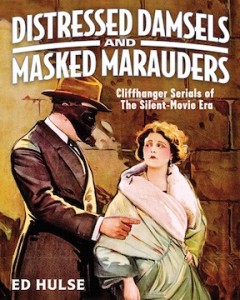 Nearly 11 months ago I announced that the long-awaited Distressed Damsels and Masked Marauders (aka The Bane of My Existence) was nearly ready for publication. Alas, this cursed project had to be back-burnered yet again, and now almost another year has passed. It was my hope — indeed, my determination — that DD&MM would be finished and printed in time for this year’s Windy City Pulp and Paper Convention, but my loss earlier this year of Murania art director Chris Kalb (whose design work is currently very much in demand and earning him far more than I can afford to pay) threw a monkey wrench in my plans. With a little help from another graphic designer, I did my own layouts for the three latest Murania Press publications: The Wilderness Trail, The Best of Blood ‘n’ Thunder: Volume Two, and the new double issue of Blood ‘n’ Thunder — all of which had been promised for delivery at Windy City. (Fortunately, Chris was able to design covers for the two trade paperbacks.) I simply didn’t have enough time to polish off DD&MM as well.
Nearly 11 months ago I announced that the long-awaited Distressed Damsels and Masked Marauders (aka The Bane of My Existence) was nearly ready for publication. Alas, this cursed project had to be back-burnered yet again, and now almost another year has passed. It was my hope — indeed, my determination — that DD&MM would be finished and printed in time for this year’s Windy City Pulp and Paper Convention, but my loss earlier this year of Murania art director Chris Kalb (whose design work is currently very much in demand and earning him far more than I can afford to pay) threw a monkey wrench in my plans. With a little help from another graphic designer, I did my own layouts for the three latest Murania Press publications: The Wilderness Trail, The Best of Blood ‘n’ Thunder: Volume Two, and the new double issue of Blood ‘n’ Thunder — all of which had been promised for delivery at Windy City. (Fortunately, Chris was able to design covers for the two trade paperbacks.) I simply didn’t have enough time to polish off DD&MM as well.
Now, however, having just finished shipping the new books to dealers and subscribers, I’m focused like the proverbial laser on the silent-serial book. The manuscript was done a long time ago, although while the book was sidelined I continued adding facts I had uncovered in the interim. A legal challenge some time back might have prevented me from reprinting exclusive material, but after a lengthy and nerve-wracking struggle I prevailed, finally getting out from under the threat of an injunction. But at last the text pages have been laid out and proofread, with only minor editorial corrections needed as I write these words.
The single most time-consuming problem I’ve faced has been doing justice to the book’s 300-plus illustrations, a sizable number of which are nearly 100 years old. I have spent hundreds — no, make that thousands — of hours doing Photoshop repairs to the still photographs, newspaper cuts, line drawings, and poster scans that accompany DD&MM‘s text. Some stills suffered from “hypo” deterioration, which I minimized by using Adobe software to recreate sections of the images. Original ads clipped many decades ago from newspapers and pressbooks were torn, chipped, and in some cases badly faded. These, too, required digital fixing; often I had to enlarge images ten times their original size and do repairs on a pixel-by-pixel basis. This type of work isn’t brain surgery, but it requires tremendous patience and lots of time, especially if one isn’t an experienced graphic designer schooled in the intricacies of Photoshop. Perhaps my biggest mistake in estimating DD&MM‘s availability was underestimating the amount of time I needed to finish this work. Several deadlines were further pushed back by the acquisition of stills even better than those I’d had originally included to represent certain titles.
Happily, the process is finally drawing to a close. Having cried wolf so many times about this book, I’m reluctant to announce another definite publication date I might miss. But this time I really am close to completing the damn thing once and for all. It’s now largely a matter of finishing the picture pages, plugging in (or correcting) captions, and reworking the index to reflect added material that changed page numbering. Then it’s up to my printer to deliver a proof copy that does justice to all the work I’ve done on the illustrations. Once I okay the proof, finals will be printed and shipped.
Bottom line: We’re looking at weeks, not months, before copies are ready for delivery — and this is absolutely the last time I’ll have to say so. To those who pre-ordered the book and have been extraordinarily patient, I can only repeat what I’ve said privately, one on one: If after reading DD&MM you don’t think it was worth the wait, I’ll refund your money in full, no questions asked. That’s how certain I am that the final product will surpass my original hopes for it.
Coming Soon: BLOOD ‘N’ THUNDER GUIDE TO PULP FICTION
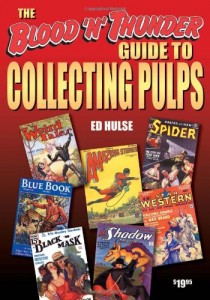 The first book bearing my Murania Press imprint was The Blood ‘n’ Thunder Guide to Collecting Pulps, which I researched for years prior to writing. Upon its publication in 2007 the Guide sold briskly, surpassing my very modest expectations in fairly short order. It did particularly well on Amazon, eventually reaching hundreds of buyers who’d never heard of the Blood ‘n’ Thunder magazine.
The first book bearing my Murania Press imprint was The Blood ‘n’ Thunder Guide to Collecting Pulps, which I researched for years prior to writing. Upon its publication in 2007 the Guide sold briskly, surpassing my very modest expectations in fairly short order. It did particularly well on Amazon, eventually reaching hundreds of buyers who’d never heard of the Blood ‘n’ Thunder magazine.
As the title made clear, my Guide was geared to those hobbyists interested in accumulating the vintage magazines themselves. Its pages carried no mention of the Print On Demand publishers whose pulp reprints were beginning to divert collector dollars from the purchase of original rough-paper periodicals. Nor did they acknowledge the mass-market anthologies that had recognized the enduring appeal of pulp fiction by including it in thick hardcover and trade-paperback editions. These omissions were not oversights on my part; they reflected a conscious decision to focus on collectable pulps only.
The early years of the 21st century had seen a dramatic escalation in prices as new hobbyists competed feverishly for pulps auctioned on eBay. I’d written the Guide with those enthusiastic and largely uneducated neophytes in mind; that experienced collectors also found it worthy was icing on the cake.
The pulp bubble — like so many others — eventually burst, and the prolonged recession from which we are only now recovering didn’t help matters. Prices began to fall as once-well-heeled hobbyists cut back on discretionary purchases. Long-time collectors who’d lost jobs were forced to sell their pulp holdings to generate income. Rare and high-grade pulps continued to fetch top dollar, and certain genres remained more popular than others, but in the main we saw prices decline as supply began to exceed demand.
Furthermore, the years since I wrote and published the Guide have seen an explosion in the quantity and quality of trade-paperback reprints facilitated by easily obtainable desktop-publishing software, the proliferation of Print On Demand companies, and the rise of social media as a means of promoting self-published books.
An even more meaningful phenomenon was the widespread embrace of “pulp culture.” Mainstream publishers increasingly used old pulp paintings on the covers of their new books. Then we started seeing enthusiastic reviews of mass-market, trade-paperback anthologies such as The Black Lizard Big Book of Pulps and its sequels edited by Otto Penzler. Suddenly, critics were enthusing over obscure yarns by writers previously known only to collectors of rough-paper magazines. Thanks to the Black Lizard tomes it was possible to walk into a Barnes & Noble bookstore and come out with a book featuring stories by Talbot Mundy, Frederick Nebel, George F. Worts, Norbert Davis, and their contemporaries. Now it’s even possible to buy hundred-year-old pulp stories in e-book form.
As early as 2009 I was getting letters from people who wanted to know if I’d be publishing updated editions of the Guide. The idea had occurred to me, but as the years went by I got the impression that another book aimed at hard-core collectors was not needed. The market had expanded to include relative newcomers to the pulp community — folks who enjoyed the fiction but had no need or inclination to collect the original magazines. Therefore I decided that, in order to broaden my book’s appeal, a revised second edition would be titled The Blood ‘n’ Thunder Guide to Pulp Fiction.
I’m happy to report that the revisions are just about finished and the book will debut this summer. The text of the first Guide is there in total, although greatly expanded. I’ve added material to every chapter — practically every page — from the earlier edition. I’ve also added chapters to cover genres I passed over the first time around: Aviation/War, Sports, Romance, and the “smoosh” (aka girlie) pulps.
Additionally, you’ll find detailed coverage of mass-market anthologies and small-press reprints of pulp fiction. There’s a lot of this material available now, so naturally some chaff is mixed in with the wheat. The new Guide turns a discerning eye on this plethora of product, offering solid recommendations along with the historical and contextual background.
The Guide to Pulp Fiction will have the same format as the Guide to Collecting Pulps: seven by ten inches, just like most rough-paper magazines of yore. Each page has two cover reproductions. Until layout is completed I won’t have an exact page total, but based on the length of the manuscript I’m guessing the book will come in somewhere between 360 and 400 pages. The price will be $29.95.
People have used such words as “formidable,” “outstanding,” and “indispensable” to describe The Blood ‘n’ Thunder Guide to Collecting Pulps. Indeed, I’ve received more compliments on this book than on any other I’ve written and/or published. It was still selling reasonably well on Amazon until I voluntarily withdrew it from circulation some months ago. Lightly used copies are listed there (not by me) for as much as $366. I have no doubt that the Blood ‘n’ Thunder Guide to Pulp Fiction will replace it as a must-have reference work. Nowhere else will you find, in one book, a complete history of pulp fiction as well as up-to-date coverage of other, more current sources of the escapist literature that shaped American popular culture throughout the 20th century.
Watch this space for further details….
BLOOD ‘N’ THUNDER #36/37: Subscriber Copies Have Shipped
As of today all subscriber copies of Blood ‘n’ Thunder #36/37 are in the mail, with the exception of a few owed to those who’ve sent renewal checks since I returned from the Windy City Pulp Convention last week. Early comments in the issue have been favorable, and according to reports from my wholesale clients it appears to be selling briskly.
If you haven’t received your copy yet, don’t worry: it’s on the way!
Windy City 2013 Convention Report
The 2013 Windy City Pulp and Paper Convention took place last weekend, and I’m still recovering. Bracketed by grueling 14-hour drives, the show found me scurrying around like the proverbial chicken without a head — changing DVDs in the Film Room every hour or two, manning the Murania Press table solo (for the first time in many years), and flitting from one dealer’s table to another in search of elusive pulps on my want list.
The con once again unfolded in the luxurious Westin hotel in Lombard’s Yorktown Shopping Center, the jewel of this upscale Chicago suburb. The Westin is my favorite of the dozens of hotels I’ve patronized in 40 years of convention-going, and its proximity to innumerable restaurants is much appreciated. Everything about this year’s visit was predictably and resoundingly favorable — except the weather. With several friends in tow, I left northern New Jersey last Wednesday, which saw the temperature rise to 80 degrees. That night, by the time we rolled into Lombard after driving many hours through steady wind and rain, the mercury was down to 41. And we didn’t see the sun until Sunday.
Not that we spent much time outdoors. As always, the convention teemed with hobbyists hot on the trail of their favorite collectibles. Windy City chairman Doug Ellis had sold out the dealer’s room in record time, renting nearly 150 tables to vendors selling original pulps, paperbacks and hardcovers, along with such related items as comics, fanzines, and newly published pulp-fiction reprints. Additionally, the current crop of “New Pulp” fictioneers was well represented. The variety of material for sale was little short of mind-boggling, although some dealer stock looked a little too familiar for my tastes.
The Windy City staff (of which, in the interest of full disclosure, I admit to being a member) did its usual fine job of mounting a memorable convention: The art show and programming, pegged to the 90th birthday of Weird Tales and the centennial of Sax Rohmer’s Fu Manchu, maintained the customary high standards. But the heart of this particular convention has always been its huckster room, with the bulk of con activity revolving around buying and selling. And the 2013 show was no exception.
Collectors of Arkham House books had to have been gratified to see so many choice titles in one room. Virginia-based dealer Dave Kurzman had his usual assortment, but DreamHaven Books’ Greg Ketter also displayed multiple copies of desirable Arkhams, the result of having recently bought two collections of same. Long-time pulp collector Richard Meli made his convention debut as a dealer with an eye-popping selection of high-grade pulps. Among the many treasures sold at his Heartwood Auctions table was a nice copy of Shadow #1, which fetched $10,000. Connecticut dealer/collector Paul Herman offered seldom-seen British editions of early Black Mask issues. And so on.
For real action, though, the Friday-night auction couldn’t be beat. For the last two years, Windy City has been auctioning inventory belonging to the late Jerry Weist, a near-legendary collector of comics and pulps as well as the publisher of the classic fanzine Squa Tront. This year’s sale included items from Jerry’s core collection. They included high-grade copies of Teens issues of The All-Story and All-Story Weekly, most carrying installments of novels by Edgar Rice Burroughs. If you know the pulp market at all, you know that these issues are scarce in any condition and high-grade copies extremely rare. So it was no surprise to see them bringing record-breaking prices at the auction.
The Murania Press table wasn’t as active as it’s been in previous years, although I brought 60 copies of the new Blood ‘n’ Thunder double issue and sold them all. I also did well with the recently released Wilderness Trail, the strong early sales of which rival those of Barehanded Castaways, up to now the best-selling title in Murania’s Classic Pulp Reprints line.
Although the Windy City con is mostly driven by commerce, it’s also a great venue for socializing, and as always I enjoyed fraternizing with friends I only see two or three times a year. The pulp-collecting community is minuscule compared to those of other hobbyist groups, but it’s populated by a grand bunch of guys (and, increasingly, gals). I enjoyed visiting with each and every one of them and only wish I’d had more time to gab with those I touched base with just briefly.
Some 488 people attended this year’s confab, thanks in no small part to a nice article in the Chicago Sun-Times and a story on one of the local TV stations. Congrats to co-chairmen Doug Ellis and John Gunnison, program-book editor Tom Roberts, and all the volunteers who worked hard to uphold the level of quality for which this convention is justifiably famous. It’s an honor to be part of such a staff, believe me.
Now it’s on to PulpFest, about which you’ll be reading more in this space over the next few months.
Correction, April 24: I was mistaken about the sale of Shadow #1. The issue was actually sold by long-time collector/dealer Jerry Schattenberg, whose glass case of rare pulps was right next to the Heartwood Auctions display. Also, the buyer informs me that the purchase price was “slightly higher” than the reported ten grand. In any case, it was a notable transaction.
Recent Posts
- Windy City Film Program: Day Two
- Windy City Pulp Show: Film Program
- Now Available: When Dracula Met Frankenstein
- Collectibles Section Update
- Mark Halegua (1953-2020), R.I.P.
Archives
- March 2023
- July 2021
- May 2021
- March 2020
- February 2020
- December 2019
- November 2019
- October 2019
- September 2019
- August 2019
- May 2019
- April 2019
- March 2019
- February 2019
- December 2018
- November 2018
- October 2018
- August 2018
- June 2018
- February 2018
- December 2017
- October 2017
- September 2017
- August 2017
- May 2017
- April 2017
- February 2017
- September 2016
- August 2016
- July 2016
- June 2016
- November 2015
- October 2015
- September 2015
- August 2015
- July 2015
- June 2015
- May 2015
- April 2015
- March 2015
- February 2015
- January 2015
- August 2014
- July 2014
- June 2014
- May 2014
- April 2014
- January 2014
- December 2013
- September 2013
- August 2013
- July 2013
- June 2013
- May 2013
- April 2013
- March 2013
- February 2013
- January 2013
- December 2012
- October 2012
- September 2012
- August 2012
- July 2012
- June 2012
- May 2012
Categories
- Birthday
- Blood 'n' Thunder
- Blood 'n' Thunder Presents
- Classic Pulp Reprints
- Collectibles For Sale
- Conventions
- Dime Novels
- Film Program
- Forgotten Classics of Pulp Fiction
- Movies
- Murania Press
- Pulp People
- PulpFest
- Pulps
- Reading Room
- Recently Read
- Serials
- Special Events
- Special Sale
- The Johnston McCulley Collection
- Uncategorized
- Upcoming Books
- Western Movies
- Windy City pulp convention
Dealers
Events
Publishers
Resources
- Coming Attractions
- Field Guide to Wild American Pulp Artists
- MagazineArt.Org
- Mystery*File
- ThePulp.Net

